Fashioning a good sales pitch is not easy — but it might be one of the most vital things a sales rep can do to improve lead conversion rates and quota attainment.
That’s because it’s no longer a “pitch” in the sense that you fling information at your customer and hope for the best, but rather a well-crafted, personalized presentation. Thus, we have curated 6 sales pitch examples to help you get inspired.
Your buyers today are more informed than they’ve ever been. Research shows that 92% of customers say that better access to information (such as product information or reviews) has changed their expectations of companies.
Another report revealed that buyers spend 67% of their journeys online, where they can do their research and seek advice from others. Those two findings highlight the fact that showing up to pitch to clients’ information they already know shows apathy on the part of a seller.
What is a Sales Pitch?
A sales pitch is generally a presentation or a dialogue between a salesperson and a lead in order to sell a service or product. This pitch is often the first interaction of a salesperson with the potential customer.
Salespeople are past the point of giving opportunities for an hour-long demonstration to trade products or services. Not everybody has that kind of time, and, to be honest, if you want an hour to convey your value proposition, you’re doing it wrong.
BusinessDictionary states that a sales pitch is an inflexible formula or bundled sales presentation conveyed in the circumstances of every sale, disregarding the needs of the prospect. It is a less charitable account of this part of the sales activity; salespeople are adjusting their pitches to their sales surroundings all the time.
A pitch is an effort by a salesperson to persuade his audience to buy his product or service or have confidence in what he is proposing. Going by this description, you need not just try to sell with your script – also tailor the pitch to convince the other party to agree with your point of view. For most parts, the new pitches fit under this explanation well.
According to Merriam Webster dictionary, a sales pitch is a communication from someone to one or more people to purchase his or her products or ideas.
In short, here is what a sales pitch attributes for in short–
- It has to do with alluring to a person or set of persons to buy goods or services.
- It can also be about an idea.
- They have to be vocal and convincing in nature.
How to make a sales pitch?
Donald Miller of Storybrand’s shows the configuration of a good sales pitch in his volume, Building a StoryBrand: Clarify Your Message So Customers Will Listen. Donald Miller describes the elements of a pitch in a concise list:
- Character – Who are your consumers, and what do they do?
- Problem Statement – What problem do they have right now?
- Plan – How does your product or facility help the customers?
- Achievement – What does success look like for your new?
The sales pitch framework
It is the one-line version, but if you have time to expand and work on a conversation properly, hint on topics of interest. Here’s a framework you can use for constructing your elevator pitch:
- Problem Statement: Start with a statement or question about the issue you plan to solve and share eye-opening statistics. Answer the why.
- Value Statement: Share an unequivocal, concise statement of value. Be action-oriented and focus on the outcome. Avoid using gobbledygook. Share profits.
- How We Do It: Highlight unique differences and clarify what you do.
- Proof: Provide a precise case study and list distinguishable accomplishments. Share industry endorsement and honors.
- Customer testimonials: Share customer instances and successes. Tell passionate and bespoke customer stories. Make it believable.
- The Engaging Question: Close the pitch with an open-ended query creating a space to have a discussion.
Many companies use success stories or case studies in their pitches to ensure the sale. Name-dropping works, so be sure to use that to your benefit. And if your product is tiny or light enough to be portable, you should always have one on-hand to show your client.
I always emphasize the need for a brief sales pitch. So keep it free of professional jargon, don’t get into the unwanted information, and be sure to talk more about your prospect and their problems than yourself.
Nothing’s more off-putting than a bragging salesperson talking about themselves, their business, or their amenities. That’s what is the “me monster.” The performer in your story is the customer, and not you — period.
6 sales pitch examples
Sales pitch example 1: The one-word pitch
Can you drip your entire demonstration down to one word? It might seem trivial, but think through the power of a brand that has a thorough command of one expression. “When any person thinks of you, they utter that expression. When anybody utters that term, they think of you,” Pink describes.
Please think of the single word that represents your offering and use it as a punchy tagline.
Sales pitch example 2: The question
When you’re confident that your buyer either wholly or somewhat understands the value of your product, use this sales pitch.
As an alternative of phrasing your pitch as a statement (“Strategic lead generation activities will reduce your company’s cost of sales”), rephrase it as a question (“Would strategic lead generation activities reduce your company’s cost of sales?”).
Why does this work? “Question pitches instigate people to come up with their reasons for agreeing (or not),” Pink writes. “And when people summon their reasons for believing something, they endorse the belief more strongly and become more likely to act on it.”
It is the upside. But if your offering’s value doesn’t sway prospects, a question pitch might invite additional scrutiny (“Would outsourcing benefit us? I’m not sure … “). So, it’s critical to assess the buyer’s mindset before using this tactic carefully.
Sales pitch example 3: Rhymes
Dr. Seuss once said, “Rhymes boost what linguists and cognitive scientists call ‘processing fluency,’ the ease with which our minds break down the stimuli, and make sense of it.”
And this has an astounding effect: Studies have established that rhyming speeches are perceived to be more truthful than non-rhyming, even when both options convey the same message, Pink notes.
So, before you dismiss rhyming as a child’s play, take into attention that a simple couplet could alter a done deal and a competitive steal. This is a sales pitch example that will surely work wonders for you!
Sales pitch example 4: The email subject-line
Salespeople are bosses at the art of crafting captivating email subject lines. Take that know-how and apply it to your sales pitches.
Pink writes that sharp email subject lines follow three principles:
- Utility
- Curiosity, and
- Specificity.
However, it would be best if you didn’t try to add each piece into a single email header or sales pitch.
“Your email subject line should be either be useful or oddly intriguing, but most likely not both,” Pink writes. It’s also worth mentioning that the more evidence buyers are contending with, the less effective curiosity provoking subject lines to become.
For the actionable takeaway, create two separate sales pitches — one valuable, and one intriguing — and layer specificity onto both.
Deploy the first if the prospect is pressed for time, or buried under information from rival vendors or internal stakeholders. Use the second if they are opening their buying journey and can travel at a more relaxed pace.
Sales pitch example 5: The Twitter (280 Characters)
Tweeting is an application in clarity and concision. What would your sales pitch be if you only had 280 characters to work?
It is expressing a Twitter pitch forces you to think analytically and creatively about the main highpoints of your offering. It can also help you fit the necessary parts of your sales demonstration.
Be mindful that while it’s easy for you to recollect all the features of your proposal, a laundry list style of functions is bound to engulf and complicate prospects.
Sales pitch example 6: The Story Telling ( Pixar Pitch)
Pixar Studios, a master at creating not just spectacular visuals but also great stories that resonate with people of all age groups alike.
Even though the stars of the studio’s movies range from automatons to sea life to talking toys, each has a comparable story structure at its core.
By phrasing your sales pitch in this way, it automatically becomes a story, which top salespeople know stick in people’s heads much better than a dry recitation of facts. Want to learn more about turning your sales pitch into a story?
Besides, this template makes it easy for sellers to place their prospects front and center — and buyers should always be the hero of a sales story.
Here’s what this type of sales pitch might look like in action:
- Once upon a time, staffing agencies struggled to find the quality talent they needed.
- Every day, they checked several social media sites and sifted through dozens of resumes searching for needles in the haystacks.
- One day, a new type of software was invented that automated this search process and quickly returned qualified candidates based on sophisticated algorithms.
- Because of that, staffing agencies were able to fill open positions more efficiently.
- Because of that, they were able to serve more clients without taking a toll on productivity.
- Until finally, the agencies vastly increased their number of customers and the amount of new revenue.
Perfecting your sales pitch is crucial to being good at selling. Practice on friends and colleagues until you master the right type of tone for you. We hope these sales pitch examples really help you in more ways than one!
How to deliver a sales pitch?
Albeit you need to sell your idea to a venture capitalist or persuade a talented developer to join your team, And while there are many other components to an effective sales process your pitch might be the most important thing to focus on right now.
Use the subsequent ideas to deliver a convincing sales pitch that drives up your lead conversion rates.
1. Define the objective of your sales pitch
Amazingly, many salespersons don’t know nearly their objective while conveying their sales pitches to their customers. The single most central purpose of your pitch should be to take your customers to the next step of your buying process.
Sales pitches need not be only about sales; your customer needs to be first educated about your company and its offerings, vision, and other essential factors.
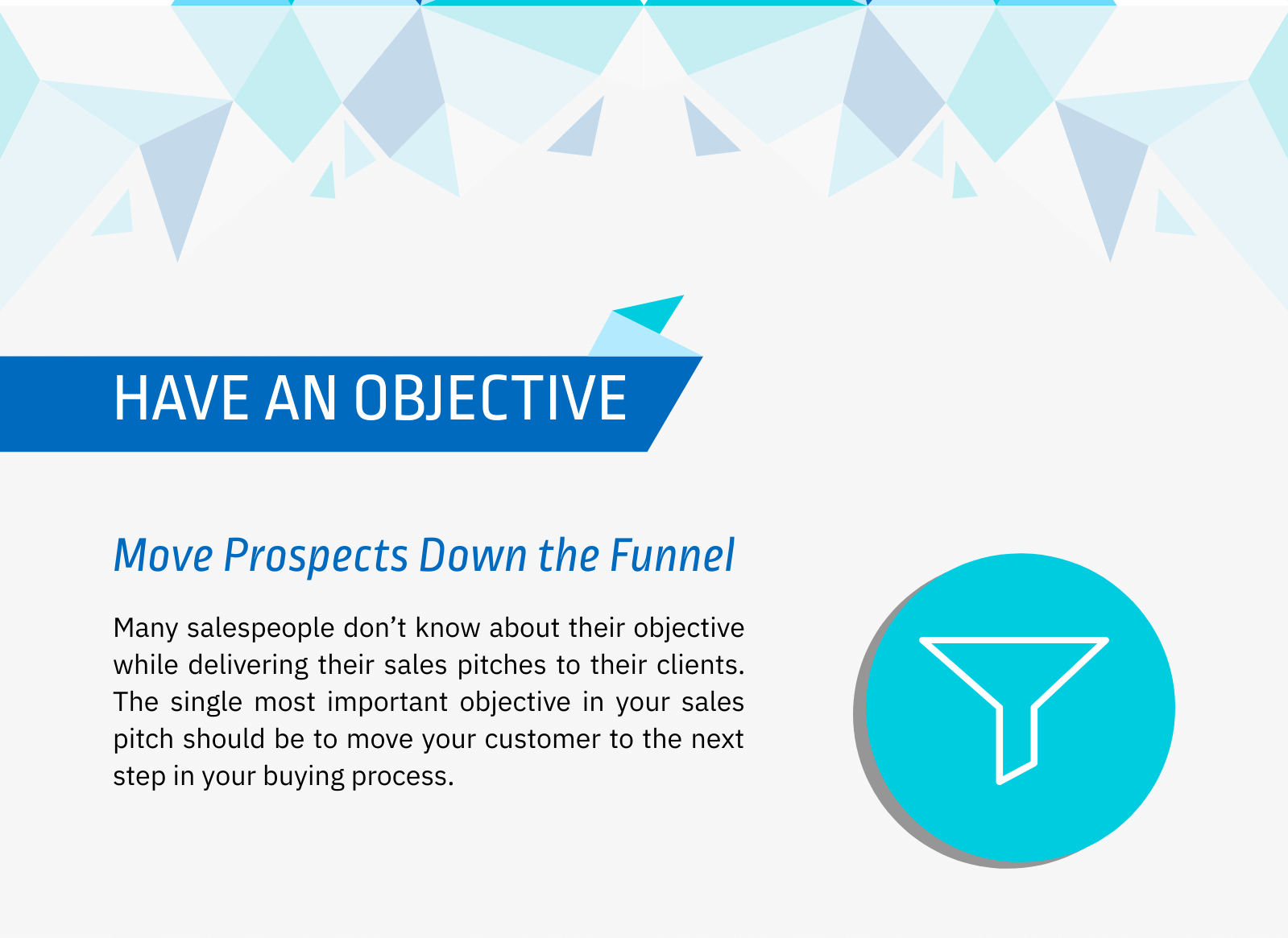
So, have you made your customers aware of your business or product? In some cases, your patron might not even know that he wants a specific solution to his issues? It’s also conceivable that he might not even know that there is a problem lurking around the corner. Your sales proposal has to cross multiple hurdles before converting your prospect into a customer.
2. How much does your customer care about your solution?
It is one of the most complicated areas while making your sales pitch. Your customer might change from one exhibition to another. In one conference, you might be presenting your stuff to the CEO of the establishment while you might be demonstrating to a department manager in another.
So your pitch should be accepting of all the levels involved. Tailored for the manager just as much as for the CEO. While the CEO is significantly engaged in increasing revenues, the junior guy is looking out for the next promotion. Your sales talk needs to pay attention to the ambitions of both these guys.
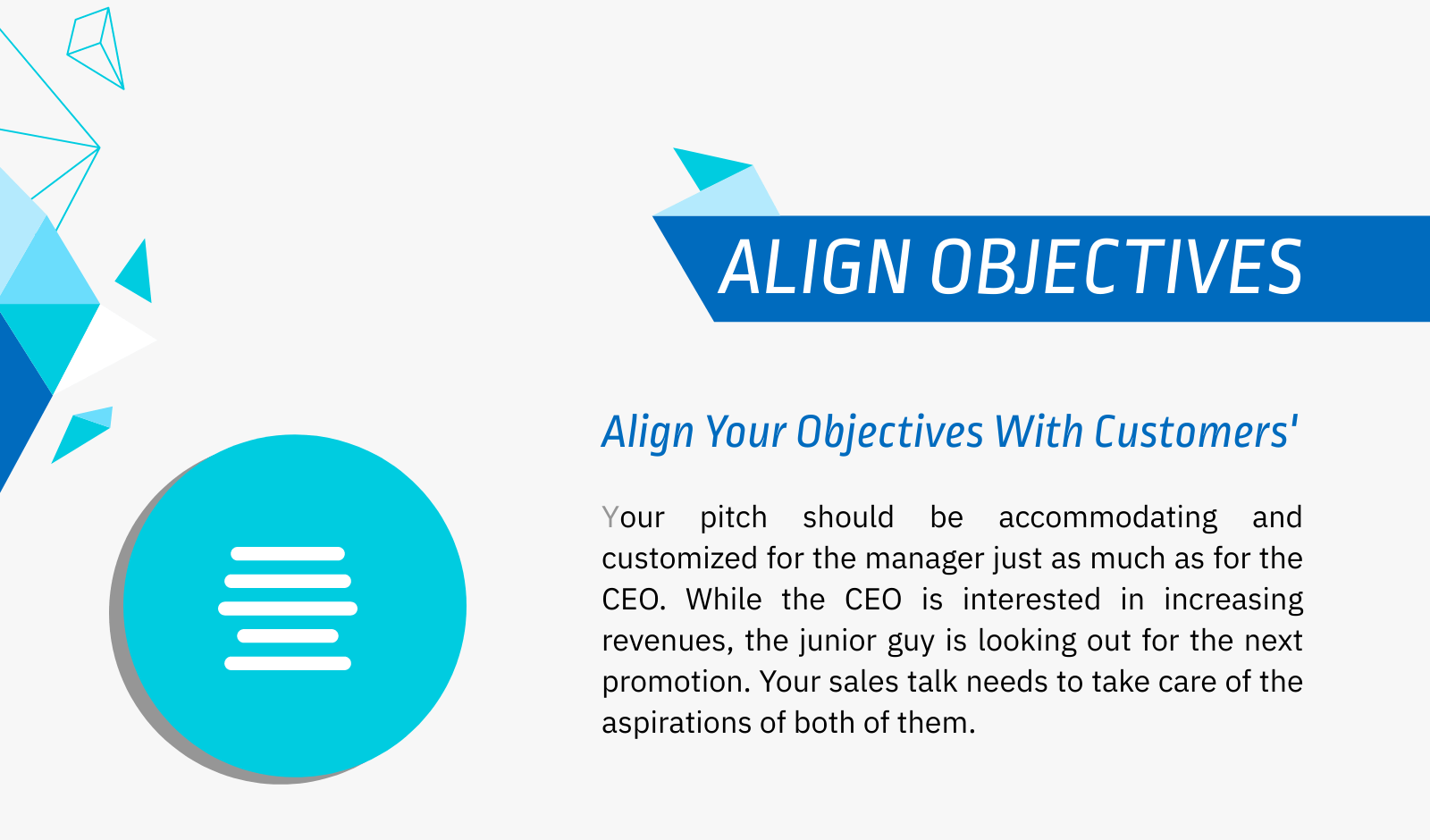
3. What is the central idea of your sales pitch?
Many salespersons veer off the central topic in their demonstrations quickly. To make an excellent demonstration, you should always emphasize the core benefit that your product is proposing. Never stray from that.
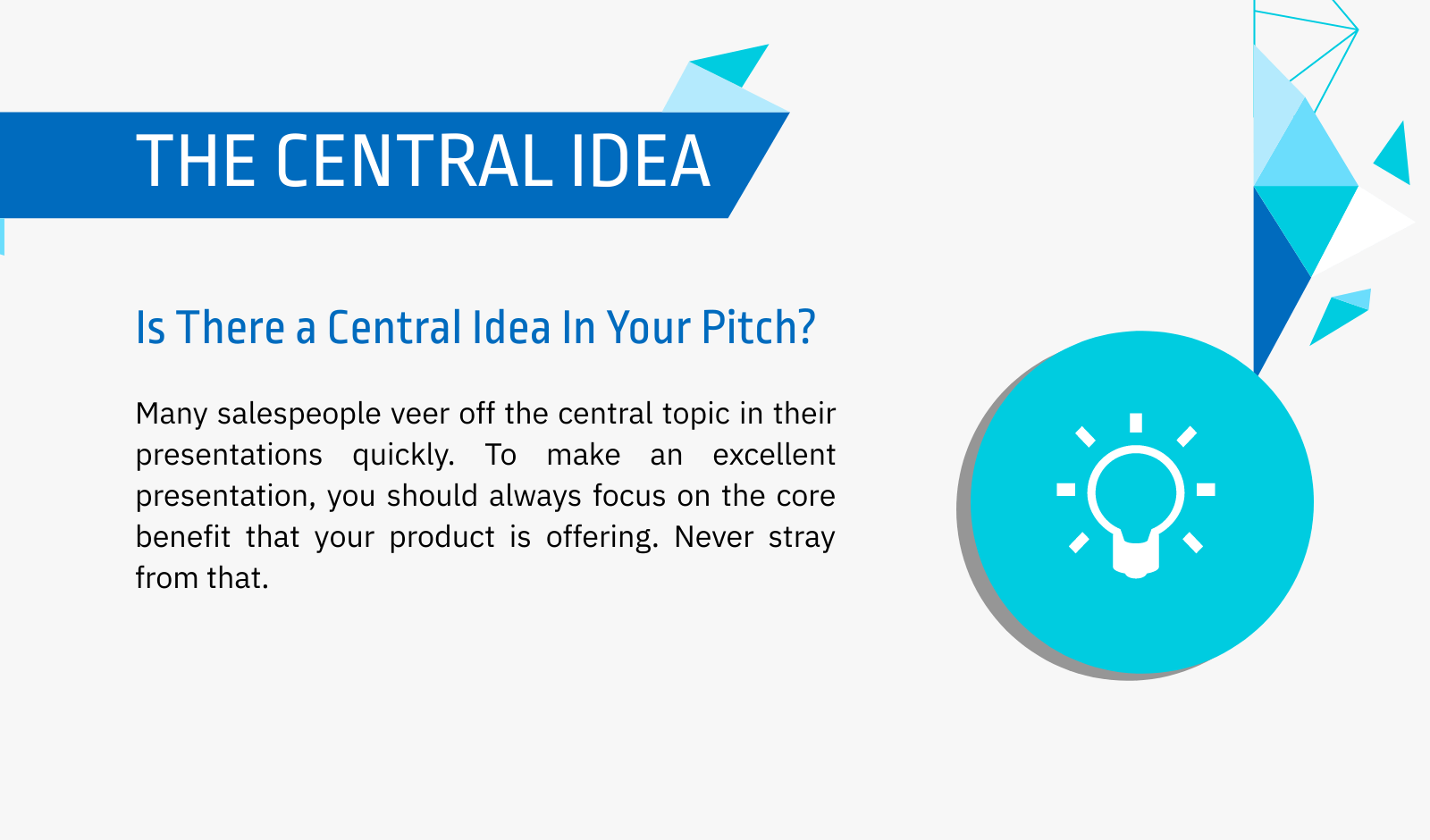
4. Customize Sales Pitches
Don’t dilute the value while showcasing your product or service to your customers. Remember that every customer is exclusive and has his own exact set of problems. Don’t cut, copy, and paste your previous demonstration onto your next one. Your clients would quickly spot this sloppy work and avoid you in the future.
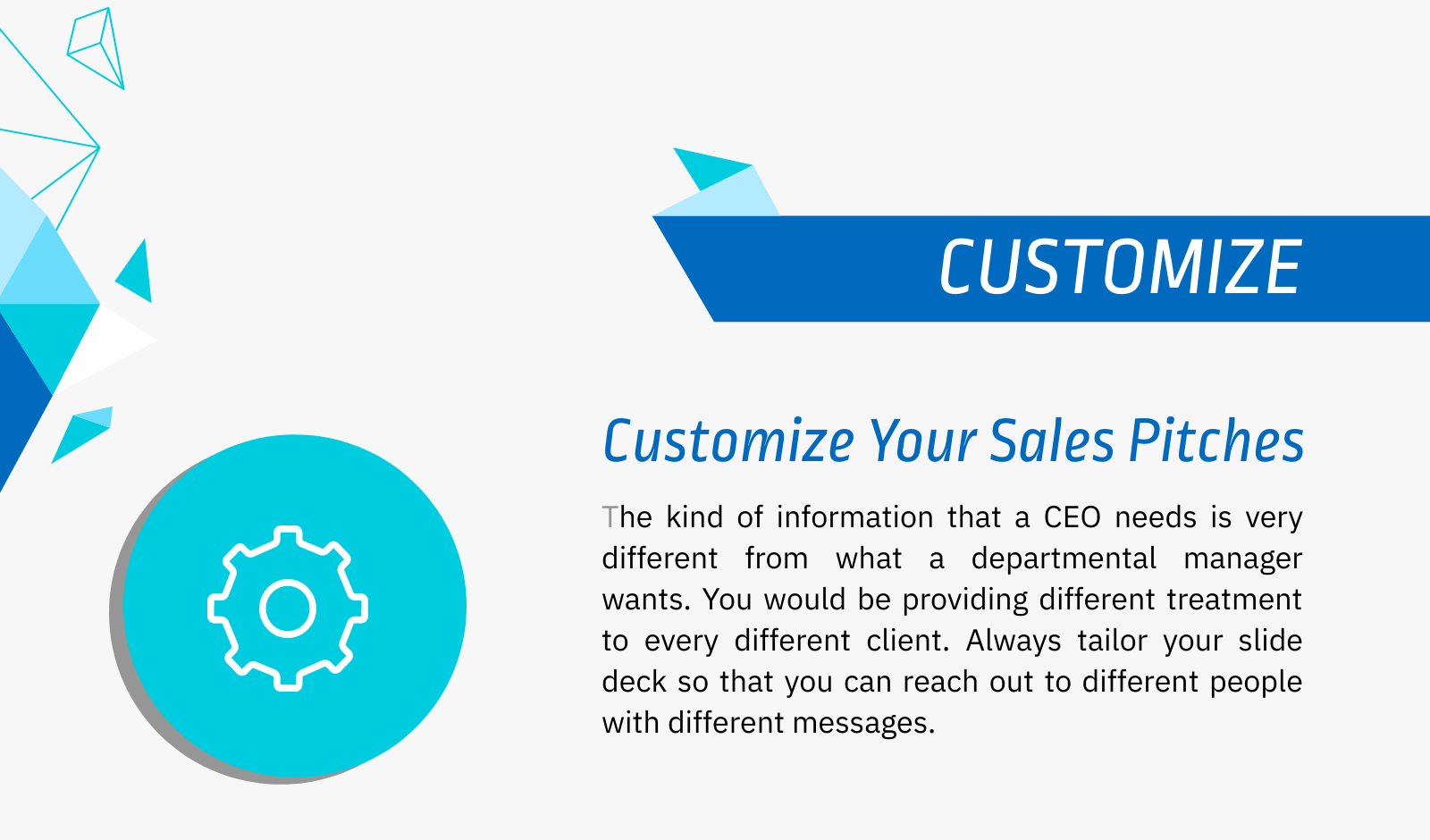
As stated above, you should also make a note of another vital thing while making your sales exhibitions – the kind of information that a CEO needs is very different from what a departmental manager wants.
You would be providing different management to every different client. However, on the inside within the same organization, you may need to customize your deck depending upon whom you are catering. Always create your sales deck so that you can reach out to different people with different messages.
5. Use the power of 3
Great salespeople stick to the 3-point rule. They never have more than three dominant ideas in their performance. Also, in each one of their presentation slides, they never have more than three pieces of information.
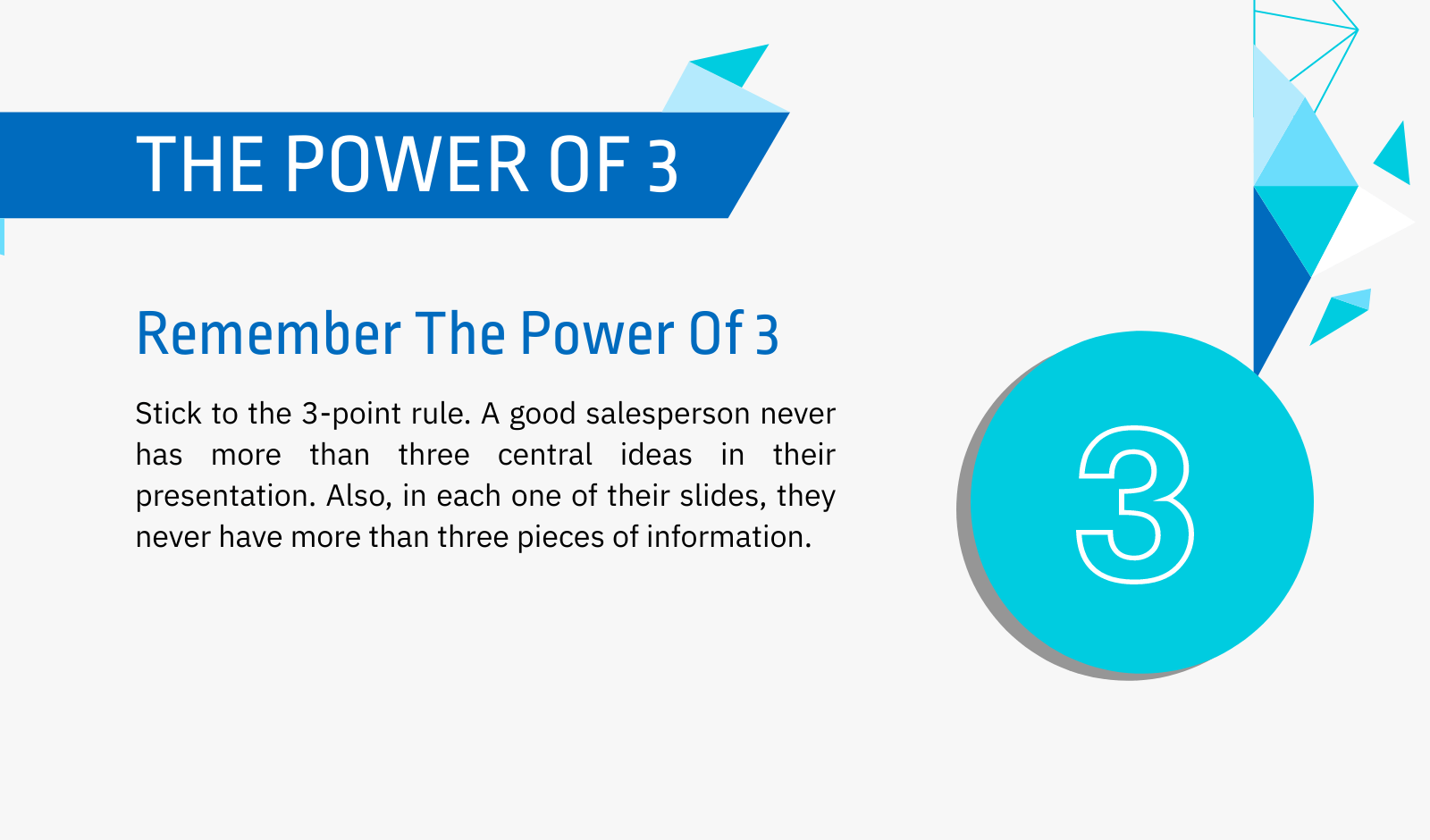
6. Be ready with a captivating verbal pitch
In some instances, you might have to deliver your sales strategy without any PowerPoint presentations. How would you prepare for this eventuality? One right way would be to internalize your written submission.
Practice reading your sales pitch without any slides, animation, and aids. It would also be a noble idea to find some commonly asked questions (FAQs) and your answers. In general, no-slide demonstrations are ice breakers and quite effective in starting conversations.
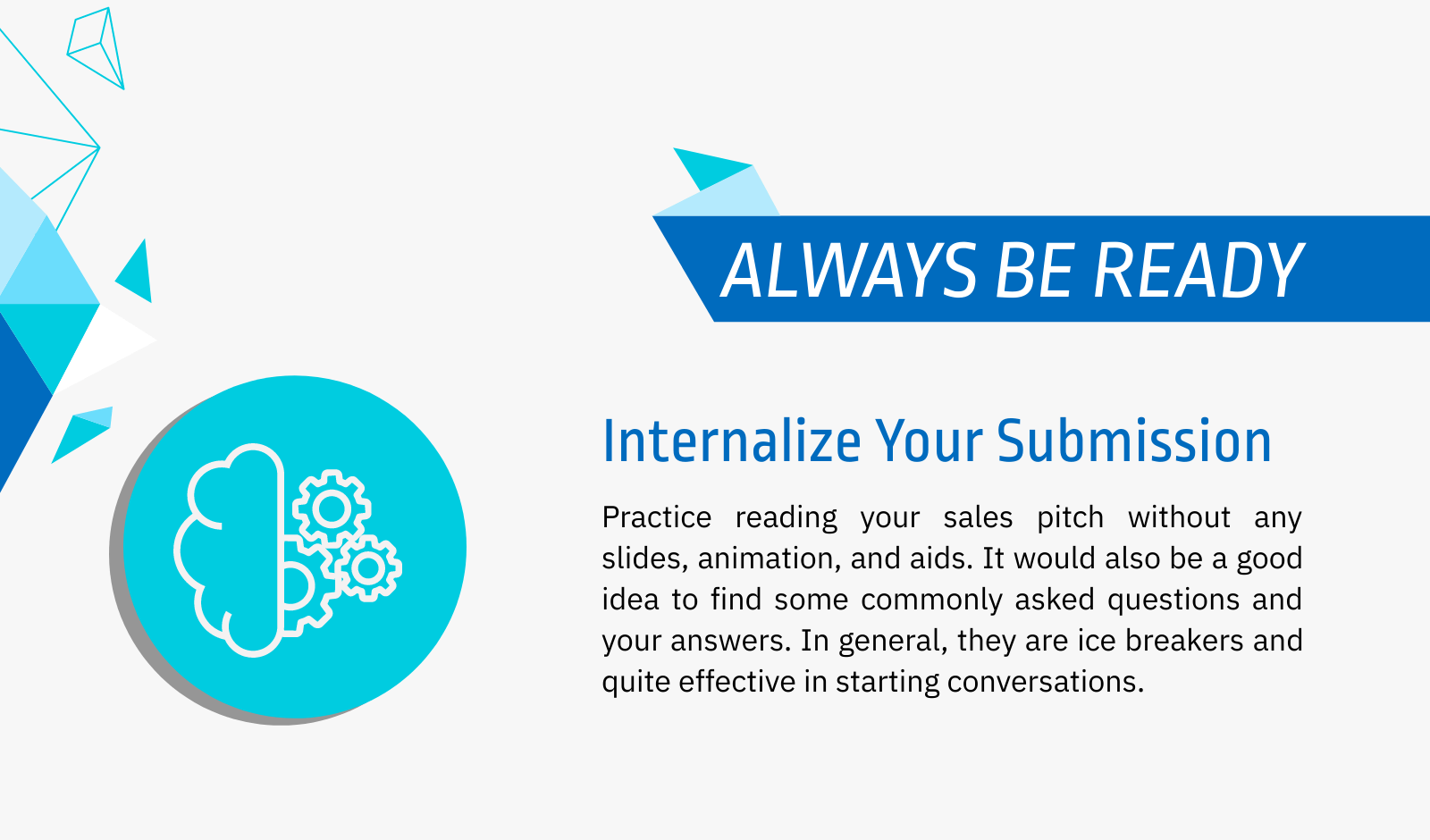
7. Set the Agenda
Set not more than 3-5 items on your agenda to stay focused. A lot of sales folks make the mistake of believing that the more people you please, the more sales you make. Selling is far from people-pleasing.
While you may want to offer a hitting solution to the problem, focusing on solving all of the issues may not work. So instead of catering to every question, postulate the problem you want to address. Then, tailor the solution as per the addressees.

8. Be Precise
Avoid jargons. Use easy to comprehend terms, and be particular to the agenda. Always focus on meeting your objectives and never wander from them. A final sales pitch is targeted, devoid of the sense of self, and personalized.
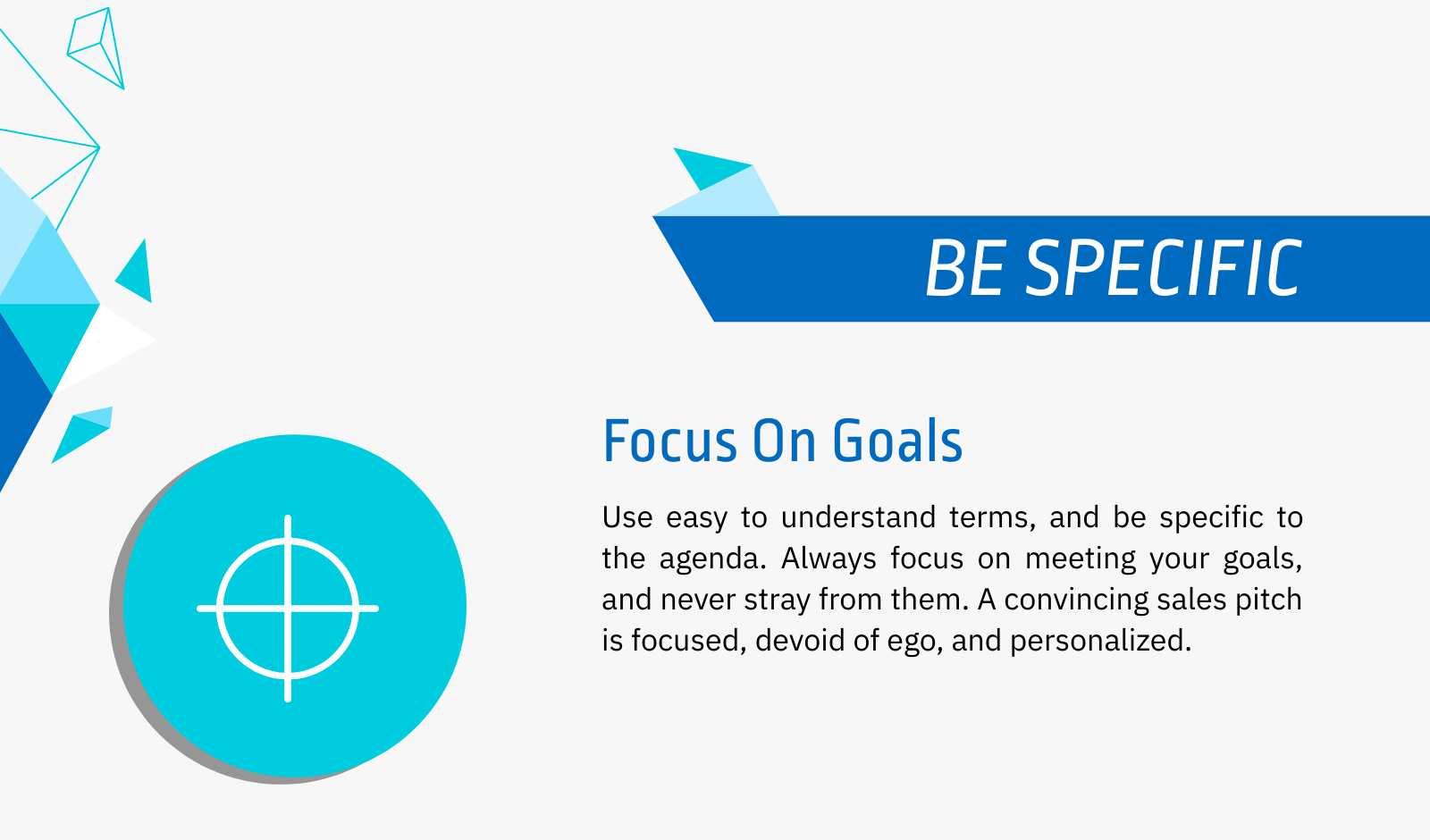
9. The Subsequent steps
Never end your presentation without citing the next steps. These could be about a free trial, a subsequent meeting, or anything else which leads to a Call-to-Action (CTA). Each time it is a good idea for you and your prospect to agree that there are indeed some next steps after this demonstration.
Remember that your sales demonstration is all about stirring your opportunity to the next step in the purchasing process.
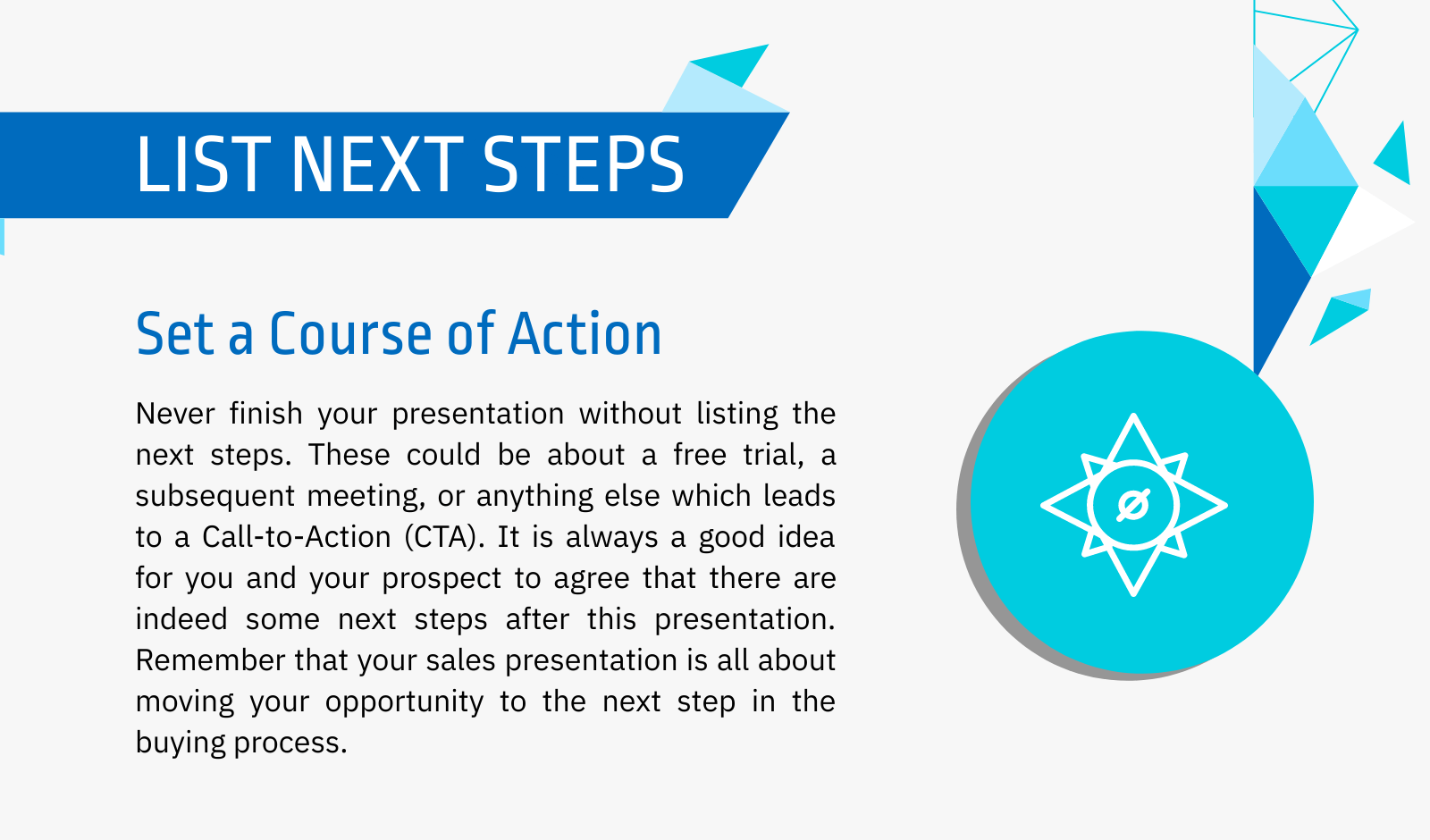
10. Conversation Matters the Most
Please remember that conveying a sales presentation is not an objective in itself. It would help if you personalized it by boosting others to express as often as possible. Conversations aid in converting a sales pitch into real sales.
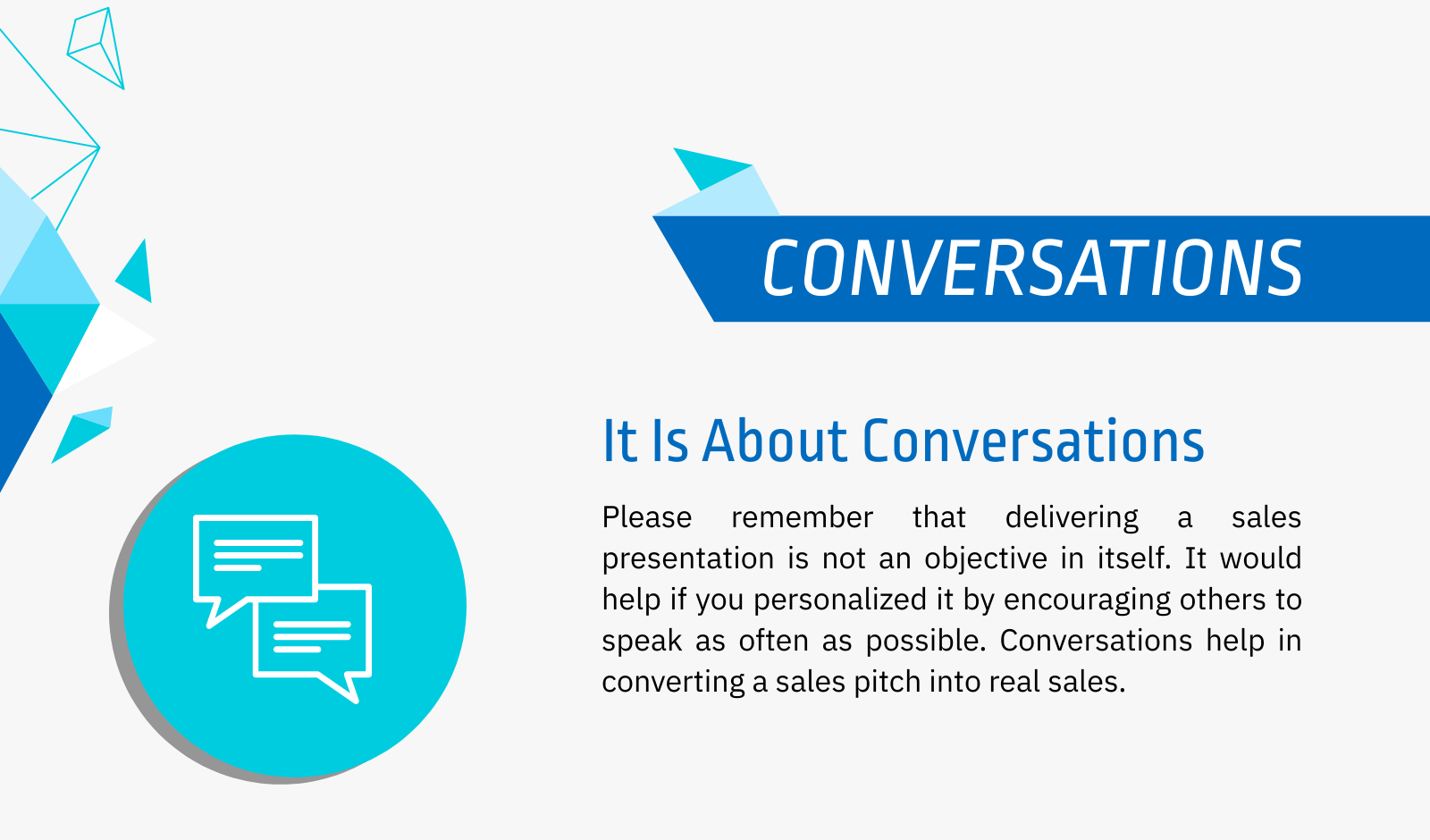
11. Identify the target
Finally, direct your sales pitch at the decision-maker. Recognize that key person in your meeting whom you would be pitching. It makes little sense to address a departmental manager when, in the same session, you also have the CEO of your client corporation. While your sales pitch should have collective relevance, the critical target needs to feel the most satisfied among the group.
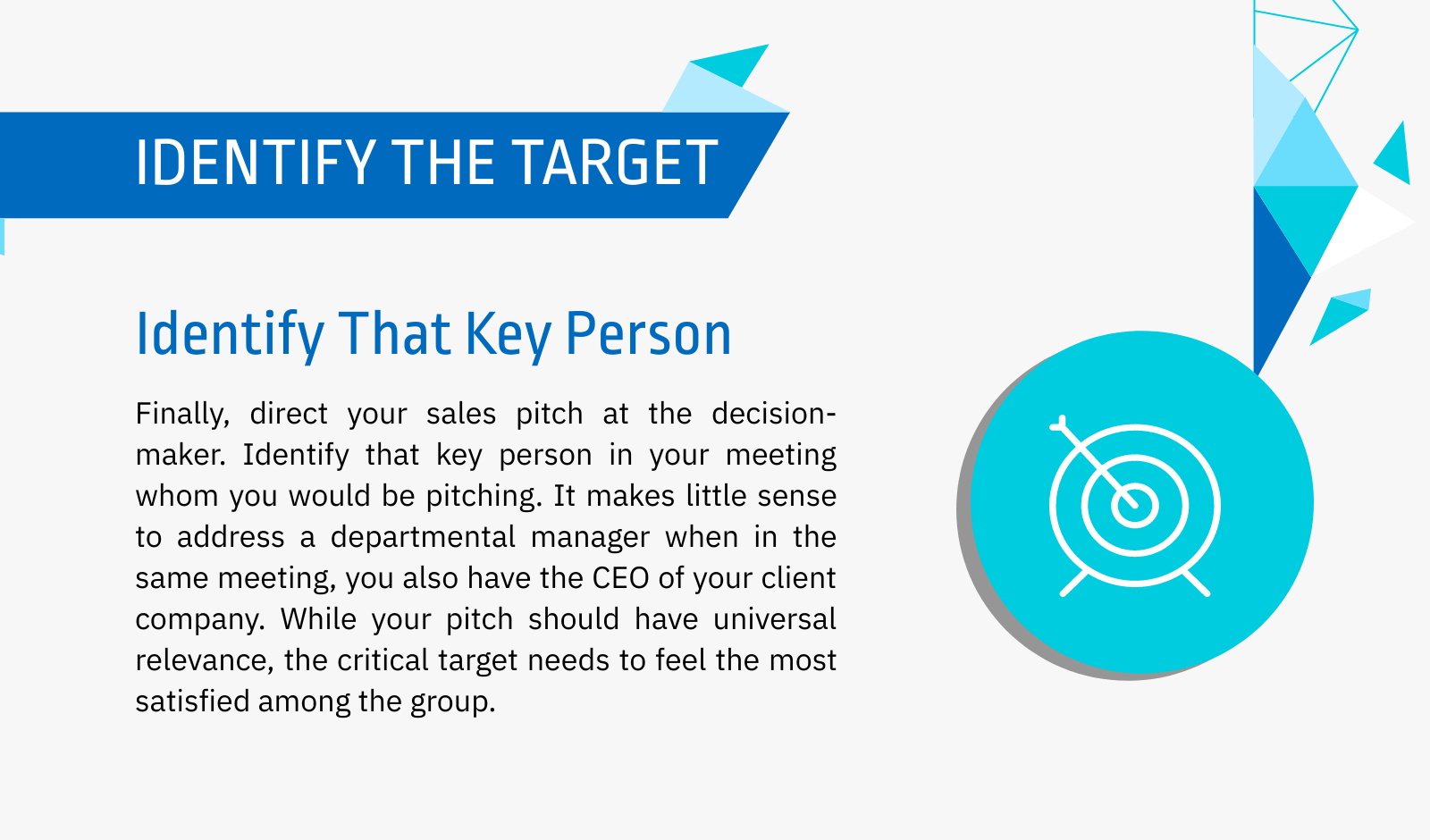
Best sales pitches examples from movies that will inspire you
1. The Famous Mark Cuban – sales pitch example
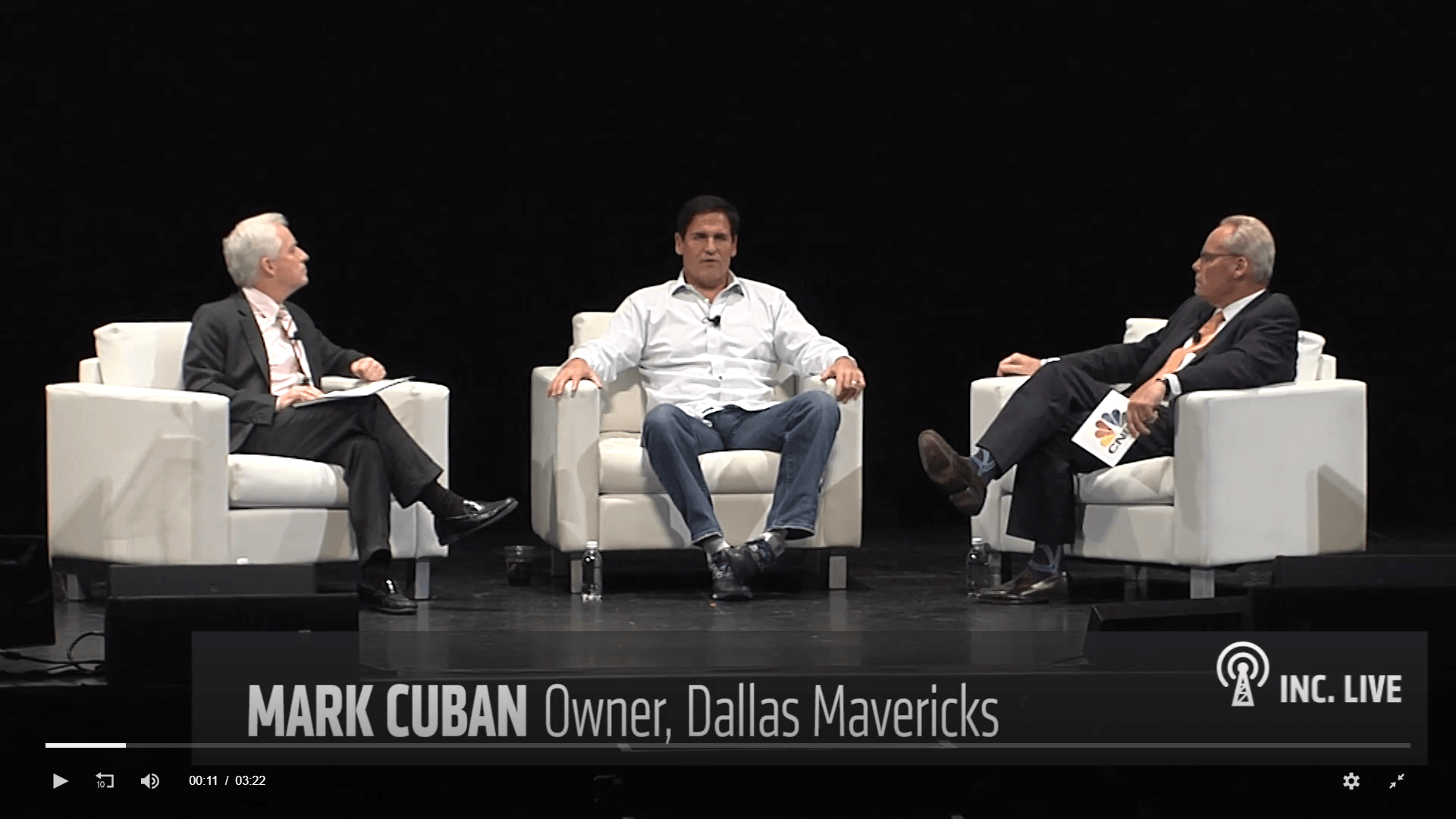
“Hi, this is Mark Cuban, the new owner of the Dallas Mavericks. I know you’ve been to a game, and I just wanted to sit here and tell you that I would love to have you back
Did you know that going to a Mavs’ game is less expensive than eating at McDonald’s? Did you know that we have tickets now that are less expensive than going to the movies?
And you’ll get a unique experience that you’ll never ever experience anywhere else.
Do you remember when your Mom or Dad took you to your first Mavs game? Do you remember how you felt? Do you get that going to McDonald’s? Do you get that going to the movies? No.
We create special experiences. I can’t guarantee you we are going to win or lose, but I can guarantee you were going to make the entertainment, so when you look at your son or daughter’s face, you will be thrilled to death and know that you can’t get that experience anywhere else.
And it’s $8 a ticket.” — Mark Cuban
(Watch him explain it here)
Here, Mark Cuban put himself right in the middle of the sales action. It’s almost unimaginable to create the perfect sales pitch if you don’t talk to real customers. He didn’t just think about the ideal sales pitch; he called hundreds of prospects to perfect the excellent sales pitch (Practice and Visualize).
Mark Cuban is a prodigy when it comes to the discovery of a blue ocean. Whom you give your sales pitch to is just as significant as how you deliver it. Cuban didn’t sit down with a phone book and cold call arbitrary Dallas citizens; he sat down with a list of previous season ticket holders (Less Competition).
He used a controlling psychological technique called Price Anchoring. Price anchoring is when you declare a price or piece of information early on in a conversation to anchor someone’s future pricing expectation. Cuban said the cost of going to McDonald’s, which most people associate with being inexpensive.
He brought up a potent memory and then tapped into a universal need of all parents: the desire of parents to create beautiful memoirs with their kids. Now that’s a Power Moment.
All Cuban had to do was jog the memory of his preceding season ticket holders why they purchased it in the first place. And this created an ‘Aha!’ instant for his prospects.
He wasn’t marketing basketball. He was peddling memories.
I want you to Reason Beyond the Features of your product or service.
- What else are you selling?
- Are you solving a pain point?
- Are you filling a promise?
2. Mad Men – Best Ad Pitch – The Carousel
“In Greek, ‘nostalgia’ literally means ‘the pain from an old wound,’”
“This device isn’t a spaceship. It’s a time machine. It takes us to a place where we ache to go again,” he says, using the Carousel to switch to a picture of his daughter Sally sitting on his shoulders, to wife Betty holding a baby girl, to him carrying his bride over the threshold. “To a place where we know we are loved.”
If you followed the series, Mad Men, it would be your most favorite moments from the series. Don Draper’s performance was something to look out for, and he became the household name in America.
Don tells his captivated audience in his greatest pitch, which occurred in the first season but would resonate all the way through the series (which, of course, traded deeply in longing in itself).
Nevertheless, how many of his later pitches mention the Kodak Carousel? How many times did he seek to take back this moment, in which he contemplates on the bittersweet hopelessness of ever truly recapturing any moment?
It is one of the perfect sales pitches one can ever ask. The sales pitch is emotionally evocative. It resonates with the target audience as it is closely related to real-life circumstances. We know that most sales decisions are emotional decisions.
Once you start resonating emotionally, there is no going back. You guarantee success when you resonate emotionally.
3. Boiler Room Giovanni Ribisi /Vin Diesel Closing the Sale
Vin Diesel: Hi Dr. Jacobs, this is Chris Marlin / JT Marlin. Marlin. He’s my father. So my associate tells me you’re interested in one of our stocks.
Doctor: “MSC sounds like it might be interesting might be doesn’t sell a stock.”
Vin Diesel: At the rate, MSC’s going. Dr. Jacobs, we’re talking very high volume here.”
Doctor: Well, I still have to run it by my people.
Vin Diesel: That’s great doc if you want to miss yet another opportunity here and watch your colleagues get rich doing clinical trials and don’t buy a share and hang up the phone.”
Doctor: Well, hold on a second now. I didn’t say that I want to talk about it already.
Vin Diesel: Honestly doc I don’t have a ton of time. This floor is blowing up right now. The whole firm is going nuts. Hold on, let me open up the door to my office. See that doc that’s my training floor now I have a million calls to make to a million other doctors who are already in the know I can’t walk. I’m sorry.
Doctor: okay okay
Vin Diesel: Now, since it’s your new account, I cannot go any higher than 2,000 shares.
Doctor: I’m sorry. Two thousand! Are you nuts! That is way beyond what I was thinking. Jesus! Listen, I’m curious why can’t you sell me anymore.”
Vin Diesel: Well, we like to establish a relationship with our clients and something small before we get to the more serious rates. Let me show you several percentage points on this short trade, and then we’ll talk about doing future business that sounds good.
Doctor: Give me the two thousand shares done. You sure you can’t do any better on this one.
Vin Diesel: I’m sorry, dr. Jacobs. I can,t. I’m sorry, all right. We’ll start with this trade then. Great! I promise we’ll swing by for the fences on the next one. Do you want that confirmation sent to your office or your mansion?
Doctor: Ha, Ha! Very funny, Mr. Marlin.
Vin Diesel: Let me put my secretary on, and she’ll take down your info there. It was a pleasure doing business with you.
Even this movie is about con-men rather than salesperson; this “concluding” scene illustrates two fundamental principles of selling:
- Inadequacy increases perceived value: In the scene, the buyer’s concern rises the instant he feels that the product will soon become unobtainable. Possibly the best real-world example of this is Pontiac. When General Motors announced it was withdrawing the brand, the cars left behind on the sales lots were bought up in days, even though previous demand had been barely warm.
- Peer pressure impacts buying behavior. In the scene, the buyer is persuaded by the vendor’s statements that other, more successful folks were purchasing the product. In the real world, businesses create this kind of peer pressure through referral accounts and case studies.
4. Jack Lemmon trying to sell an investment in Glengarry Glen Ross -1992 (Example of a Bad Pitch)
Shelley Levene: Mr. Spannel. Shelley Levene, I was speaking to your wife earlier. I see you interested in fishing. Oh, I fished myself for thirty years. Muskie Wisconsin Oh! Beauty. Where’s the missus?
Larry Spannel: Not in yet. Uh! What was this in reference to?
Shelley Levene: When I spoke to your wife earlier on the phone, I call I’m in town with Rio Rancho.
Larry Spannel: Yes, yes, I’m sorry she said you had some sort of Summer Award.
Shelley Levene: I was speaking to the people in my sales organization, my representatives in this area, and Mr. Spannel think your name is Larry. Might have I call you Larry? Larry, we had a consultant then he made me an offer. He offered me two hundred and thirty thousand dollars to promote a sales plan. You see, a plan to present our investment opportunities in Rio Rancho to the public. Well, I said he’ll let me save you the 230 and pass the savings along to the investor. My people immediately said, ” Whoa, how do you do that? How can you present investment opportunities without television, without magazine ads? I said, ” You take something this good you go to a man has invested in the past. You go to him directly and offer the Money to him. Rebate and don’t give it to this expert.”
Larry Spannel: So you here to sell me some land.
Shelley Levene: No, oh, I wouldn’t try to sell you, Larry. I would leave that to the salesmen. You know people who want to own land. I think something has to be fed watered and painted, don’t invest in it. And, that motto has stood me in good stead, mister. I never.. Just call me Shelley. I have never been afraid of them.
Larry Spannel: Hey, I’m walking out the door. I’ve got to pick up my wife at…
Shelley Levene: Then let’s take my car. We’ll take her up together. Spoke to a little woman on the phone can’t wait to be there.
Larry Spannel: No, we’ve got we’re going over to our relative.
Shelley Levene: Oh! You didn’t say anything.
Larry Spannel: I’m sure she forgot. She got on a plane to Florida. Well, I’m so sorry if we put you out.
Shelley Levene: No, you didn’t go. Yeah! I’m just trying to think Larry. You know that’s the only parcel that I’ve got. You know what I’m gonna do. I’m gonna go back to the computer, I’m gonna pull another one, and we’re gonna speak to your relatives. Oh! Come on. You’re a businessman, Larry. And, I am so elicited my god I’m in the act of giving a gift away.
Larry Spannel: Hey, I don’t want to buy land. I don’t want to invest in the land. I have nothing. Yeah, she took the call without my knowledge. I have no business that I wish to transact.
Shelley Levene: Larry, I don’t want to tell you how to handle your wife.
Larry Spannel: My wife filled in a form, and we have been played for the last year.
Shelley Levene: Mine’s the situation that I’m trying to know. Larry, I know you do understand.
Larry Spannel: Thank you. No!
The most famed scene in this exceptional movie is Alec Baldwin’s “Always Be Closing” monologue of sales training. However, from a business viewpoint, there’s more to absorb from the scenes where the actual selling takes place.
While Jack Lemmon’s miserable sales pitch shows his desperation and pitiable condition, the concept behind it–build a connection with the customer first–is a perfectly rational sales strategy.
5. The Music Man – The first 3 minutes : sales pitch example
I wished I would put the entire transcript and break it down. It doesn’t make sense as no one makes sales like this nowadays. However, there is a learning and huge take away even if the scene is as corny as it may appear.
Harold Hill is an example of effective selling — if you remove the cornball appearance. Harold Hill’s sales strategy is sound. He initiates his sales pitch by getting the attention of his potential customers, makes them envision how horrifying the future will be if they don’t buy his product.
- He evaluates the customer’s current state. Rather than give a packaged sales pitch based upon his expectations, he figures out something about the current state of his customer’s businesses that creates a lever for him to sell.
- He delineates the problem. He makes the populations of River City mindful that the pool table is the first indication that the town is suffering a moral crisis. Then he solidifies that issue and makes it more and more vivid and vital.
- He defines the solution. In his succeeding closing pitch (the famous “76 Trombones” number), he provides a solution to the issue that he fashioned in the setup pitch. Then he fleshes out the answer so that it appears unavoidable.
- He allures the buyer’s emotions. Throughout his demonstrations, he draws comparisons between fear of the appalling state that will occur if people don’t purchase his product and the superiority that customers will have as a result if they do.
- He has faith in his product. Yes, even though he’s running a ploy, he trusts that his product is valuable, as shown in the vital moment when Harold tells the boy he’s befriended: “I always believe there’s a band, kid.”
6. Jerry Maguire – Show me the Money
Jerry Maguire: Rod, it’s Jerry Maguire.
Rod: Jerry Maguire! How am I doing? I’ll tell you. I’m sweating. Where’s my contract? Bob Sugar says,” I’m missing out being with you.” You hear what I’m saying?
Jerry Maguire: That’s why I called.
Rod: No, no… Do you truly hear what I’m saying?
Jerry Maguire: The best thing is we have to get together in person. Hold on a minute, Rod.
Rod: Did you tell my wife that I need personal attention. That’s what you told my wife.
Jerry Maguire: That’s what I said.
Rod: Good! We’re just getting started on the things you need to know. You can take notes if you want. I am a valuable commodity. There are dudes out there trying to kill me. I tell myself to get killed. I still catch the ball. Touchdown! I make miracles happen. I’m from Arizona. I broke Arizona records. I went to Arizona State!
Jerry Maguire: And now you want Arizona dollars.
Rod: Exactly. I’m sitting here with an ant problem. My brother Tee Pee’s room is flooded. I am a role model. I have a family to support! My house is falling apart. No one’s looking out for me. I’m supposed to be a superstar.
Jerry Maguire: Are you in or out?
Rod: I want a contract in Arizona. I like you. My wife likes you. You’re good to my wife. I will stay with you.
Jerry Maguire: That’s great.
Rod: That’s what I’m gonna do for you. God bless you, Jerry. This is what you’re gonna do for me.
Jerry Maguire: What can I do for you? You just tell me.
Rod: It’s personal and very important. Hell! It’s a family motto. Are you ready, Jerry?
Jerry Maguire: I’m ready.
Rod: Here it is. Show me the Money.
- Never blame Your Customers: In the movie, Jerry Maguire talks to his only client, “Rod Tidwell,” who has got attitude issues and wants a 10-million-dollar contract, openings to act in product advertisements of well-known brands. However, many do not think him to be worthy enough for such extraordinarily valued deals. Rod keeps shouting on the phone, “Show me the money.” He doesn’t worry about “Jerry’s” precarious situation and is focused only on his financial difficulties, his family, and his imminent future. Every human wants to gratify his own needs or desires. His goal is not to consume your product or service. Realize that the customer may not always be correct, but do not blame the consumer for the snags.
- Personal Relationships: Everyone is engrossed in themselves; every customer desires special consideration. They need preference — They need an exceptional guarantee that they are also one of the chosen clients. Preference brings fidelity. Fondness makes the sale. To appreciate their emotional requirements, needs, we need to create personal relations with our customers — Need to participate at a deeper level, and build a lasting association with clients.
- Listening Is the Most Important Skill: Many customers may not be aware of their inherent needs and the obstacles they face in achieving their target. Maybe the clients are unintentionally making blunders. Listening more will help you establish ‘personal relationships.’ It would, in turn, help you to appreciate their choices, the reasoning behind their actions, what are their pain points, what are anxious about, and the kind obstacles they are facing. Once you recognize them, you can customize your solutions to lead them towards a purchase and building a lasting relationship in the process.
7. The Big Short (2015) – Jared Vennett’s Pitch to Front Point Partners
Partners: okay… Hi… how are you?
Jared: Have a seat!
Partners: Hey mister Vennett from Deutsche bank, whom do we have? So, how many people have you talked to about this trade?
Jared: A few. There’s definitely some interest. Ohh…
Partners: Which is why you’re here talking to us on the wrong number? Sounds like there’s a lot of interest.
Jared: All right. A few people have us in, just to laugh at me on this deal, is that you? Is that what this is?
Partner: That’s not what this is; that’s just how the mark is. Let’s see what you got.
Jared: I’m sorry, do you smell that? What is that?
Partner: What? What’s that smell? Cologne?
Jared: No! Money. I smell Money… This is your basic mortgage bond. Alright, the originals were simple. They were just thousands of AAA-mortgages bundled together, guaranteed by the us-government. The modern ones are different. They’re private. And they’re made up of layers of tranches. Highest level AAA’s getting paid first. The lowest rated Bs getting paid last, taking on defaults first. No, obviously, if you’re buying Bs, you could make more money. But, they’re a little risky, sometimes they fail. Somewhere along the line, these Bs and bb’s went from a little risky to dogshit. Where’s the trash? I’m talking rock-bottom fico-scores. No income-verification. Adjustable rates… Dogshit! The default-rates are already up from one to four percent fellas. And if they rise to eight percent… And they will! A lot of these BBB’s are going to zero too. And that…It is an opportunity.
Partner: Okay, you’re saying that at 8 percent, the bonds fail, and we’re already at 4 percent?
Jared: That’s right.
Partner: If they go to eight… it’s Armageddon. Yeah, that’s right. How come nobody’s talking about this? And you’re completely sure of the math?
Jared: I’m sure of the math.
Partner: so… you’re offering us a chance to short this pile of blocks? How?
Jared: With something called a credit default swap. It’s like insurance on the bond, and if it goes bust, you can make 10-to-1. Even 20-to-1 return, and it’s already slowly going bust.
Partners: 10-to-1, 20-to-1… No way!
Jared: And no-one is paying attention. No-one is paying attention because the banks are too busy getting paid obscene fees to sell these bonds.
Partners: But wait… you are the bank. You work for the bank; I bet your margins are pretty nice and fat.
Jared: Let’s not talk about my margins, by the way. Being nice and fat… that’s a nice shirt, do they make it for men?
Partners: Aren’t you the bank?
Jared: I work for the bank! I don’t think like a bank. Big banks, small bank… I like to make Money. All right…Let me put it this way… I’m standing in front of a burning house, and I’m offering you fire insurance on it.
Partners: How can these underlying bonds be…As bad as you say? It wouldn’t be legal!
Jared: Nobody knows what’s in them! Nobody knows, what’s in the bonds, I’ve seen some that are 65 percent AAA-rating. That I know, for a fact, are filled with 95 percent sub-prime shit with FICO Score below 550.
Partner: Get the fuck out of here!
Jared: Want me to really blow your mind? When the market deems a bond too risky to buy, what do you think we do with it? Take a guess!
Partner: I don’t know, you tell me!
Jared: All right… Do you think we just warehouse it on the books? No, we just repackage it, with a bunch of other shit that didn’t sell and put it into a CDO (Collateralized Debt Obligation).
Partner: A CDO?
Jared: Yes… a CDO. What is that? Where we take a bunch of Bs, bb’s, and BBB’s that haven’t sold, and we put em in a pile… And when the pile gets large enough, the whole is suddenly considered ‘diversified.’ And then… the whores of the rating agency, give it a 92 / 93 percent AAA-rating, no questions asked…
Partner: Holy… what! Say that again!
Jared: Collateralized debt obligations. It’s important to understand because it’s what allowed the housing crisis to become a nationwide economic disaster. Here’s world-famous Chef Anthony Bourdain to explain.
Chef Anthony Bourdain: Okay, I’m a chef on a Sunday-afternoon setting the menu of a big restaurant. I ordered my fish on Friday, which is the mortgage bond that Michael Burry shorted. But… some of the freshes doesn’t sell. I don’t know why, maybe it just came out, how Anthony has the intelligence of a dolphin. So… what am I gonna do? Throw all these unsold fish, which is the BBB-level of the bond, in the garbage? And take the loss? No way! Being a crafty and morally honor chef that I am… Every crappy level of the bond I don’t sell… I throw into a seafood stew. It’s not old fish! It’s a whole new thing! The best part is… They’re eating retailed halibut! That… is a CDO.
Partner: I just need to know how these could possibly be correlated. You’re like d-d-Dora, the explorer. You’re the first person who has found this… So.. Hold on. So mortgage bonds are dogshit? Cdo’s are dogshit wrapped in catshit.
Jared: Yeah… that’s right! Institutions treat these CDO’s like they’re as solid as treasury bonds. And they’re going to zero.
Partner: No, that can’t be right, there, there, are 500 billion in housing bonds sold last year alone rating agencies, the banks… The fucking government? You’re saying they’re all asleep at the wheel.
Jared: Yeah! My whole department is long on this stuff. They call me chicken little. They call me bubble-boy. A’s… zero. B’s… Zero, bb’s… zero. Bbb’s… zero. And then that happens!
Partners: What… is that? That’s America’s housing market. Thank you.
- Capture Interest: At the beginning of this scene, Jared unveils his stack of Jenga blocks marked with triple-A at the top and down to blocks of B mortgages. You can easily see that he captured his audience’s attention with this powerful prop. It is a herculean task of trying to explain the complex mortgage crisis to his prospects.
It would help if you understood that people are largely visual creatures and that showing them something physical allows prospects to both see and touch, and it works magic in a sales presentation. - Be an Authority: Now, Jared has his audience’s attention. He now faces the intimidating task of explaining the intricate mortgage crisis to his prospects. However, Jared continues to use his visual aid to teach and exhibit the problem with the CDOs and the looming financial Armageddon. He overcomes the sales impediments through his vast source of knowledge. Don’t hesitate to prove to your customers wrong. Sometimes it may work in your favor. Jared quickly educates his prospects on both the problem and the opportunity they have ahead.
- Be a Little Dramatic: The audience will remember less than 10% of a regular speech or sales demonstration. Be a little dramatic in a speech or sales presentation, your audience can retain as much as 65% of the material, weeks after hearing a talk. How do you appeal to the public? Custom speech writers fix the most common problems when addressing spectators.
It is not hard to imagine Jared’s last gestures where he pulls enough Jenga pieces to cause the crash, which he did to exemplify the financial collapse. The powerful effect in this demonstration had was evident when you realize Mark Baum’s reaction by questioning, “what is that?” Jared replies in a somber tone, “That’s America’s Housing Marketing”!
Hearing that talk incited Mark to probe the opportunity and eventually bet on shorting the housing market with Jared’s Credit Default Swamps!




